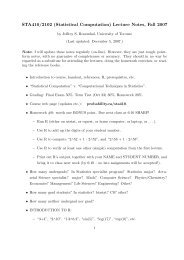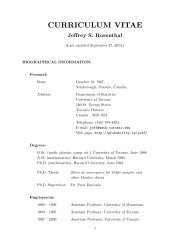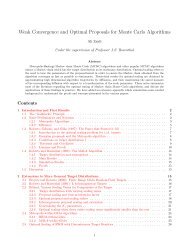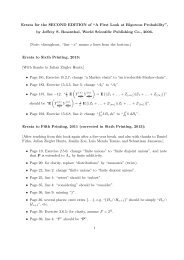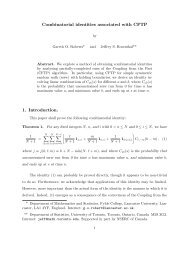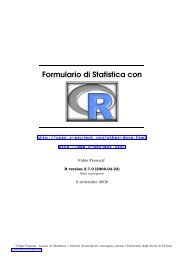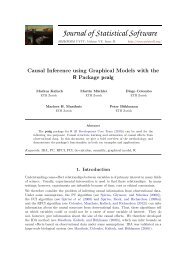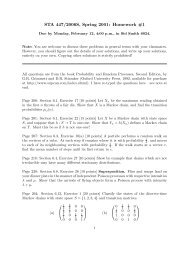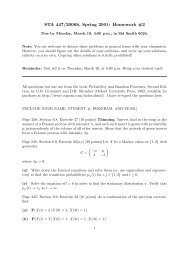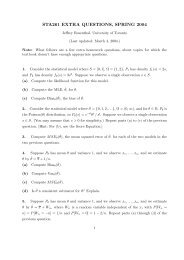Package 'extRemes' - What are R and CRAN?
Package 'extRemes' - What are R and CRAN?
Package 'extRemes' - What are R and CRAN?
You also want an ePaper? Increase the reach of your titles
YUMPU automatically turns print PDFs into web optimized ePapers that Google loves.
4 atdf<br />
taildep: Estimate chi <strong>and</strong>/or chibar; statistics that inform about tail dependence between two<br />
variables.<br />
atdf: Auto-tail dependence function <strong>and</strong> plot. Helps to inform about possible dependence in the<br />
extremes of a process. Note that a process that is highly correlated may or may not be dependent in<br />
the extremes.<br />
decluster: Decluster threshold exceedance in a data set to yield a new related process that is more<br />
closely independent in the extremes. Includes two methods for declustering both of which <strong>are</strong> based<br />
on runs declustering.<br />
extremalindex: Estimate the extremal index, a measure of dependence in the extremes. Two<br />
methods <strong>are</strong> available, one based on runs declustering <strong>and</strong> the other is the intervals estiamte of<br />
Ferro <strong>and</strong> Segers (2003).<br />
devd, pevd, qevd, revd: Functions for finding the density, cumulative probability distribution<br />
(cdf), quantiles <strong>and</strong> make r<strong>and</strong>om draws from EVDs.<br />
pextRemes, rextRemes, return.level: Functions for finding the cdf, make r<strong>and</strong>om draws from,<br />
<strong>and</strong> find return levels for fitted EVDs.<br />
To see how to cite extRemes in publications or elsewhere, use citation("extRemes").<br />
Acknowledgements<br />
Funding for extRemes was provided by the Weather <strong>and</strong> Climate Impacts Assessment Science<br />
(WCIAS, http://www.assessment.ucar.edu/) Program at the National Center for Atmospheric<br />
Research (NCAR) in Boulder, Colorado. WCIAS is funded by the National Science Foundation<br />
(NSF). The National Center for Atmospheric Research (NCAR) is operated by the nonprofit University<br />
Corporation for Atmospheric Research (UCAR) under the sponsorship of the NSF. Any<br />
opinions, findings, conclusions, or recommendations expressed in this publication/softw<strong>are</strong> package<br />
<strong>are</strong> those of the author(s) <strong>and</strong> do not necessarily reflect the views of the NSF.<br />
References<br />
Coles, S. (2001) An introduction to statistical modeling of extreme values, London, U.K.: Springer-<br />
Verlag, 208 pp.<br />
Ferro, C. A. T. <strong>and</strong> Segers, J. (2003). Inference for clusters of extreme values. Journal of the Royal<br />
Statistical Society B, 65, 545–556.<br />
Gillel<strong>and</strong>, E. <strong>and</strong> Katz, R. W. (2011). New softw<strong>are</strong> to analyze how extremes change over time.<br />
Eos, 11 January, 92, (2), 13–14.<br />
atdf<br />
Auto-Tail Dependence Function<br />
Description<br />
Computes (<strong>and</strong> by default plots) estimates of the auto-tail dependence function(s) (atdf) based on<br />
either chi (rho) or chibar (rhobar), or both.



